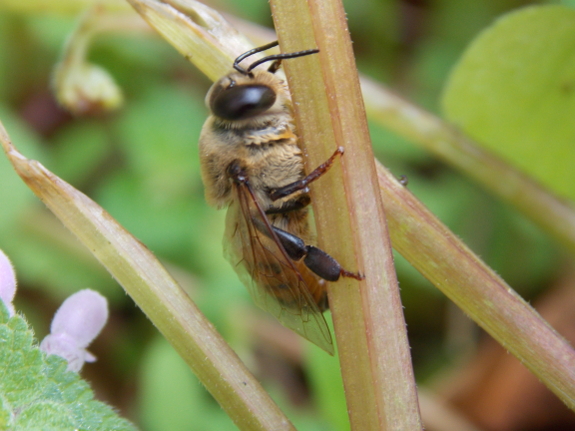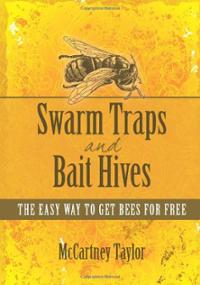
Swarm Traps and Bait Hives

 The only downside of Swarm
Traps and Bait Hives
by McCartney Taylor is the price --- $6.99 for the ebook or $16.16 for
the paperback. As you've probably noticed, I price ebooks of this
length at 99 cents, and I don't make print books available because I
figure no one would want to pay $20 for a copy of Incubation
Handbook,
for example. However, I went ahead and bought Taylor's paperback
because I wanted something I could easily work from, and figured I'd
likely lend the text to friends once I'm done.
The only downside of Swarm
Traps and Bait Hives
by McCartney Taylor is the price --- $6.99 for the ebook or $16.16 for
the paperback. As you've probably noticed, I price ebooks of this
length at 99 cents, and I don't make print books available because I
figure no one would want to pay $20 for a copy of Incubation
Handbook,
for example. However, I went ahead and bought Taylor's paperback
because I wanted something I could easily work from, and figured I'd
likely lend the text to friends once I'm done.
And I wasn't
disappointed. After an hour perusing the elegant and
well-written interior of this 50-page book, I was itching to go out and
build a swarm trap. I'll write some followup posts once I've
created my first box, but for now, here are some tips to get you
started:
- Leave your swarm traps up between a couple of weeks before you usually see swarms (probably April around here) until about July.
- The best swarm trap is dark inside,
has an entrance hole near the
bottom about 1.5 to 2 inches in diameter, includes frames with a bit of
old wax on one or more, and has a capacity of around 10 gallons.
An 8-frame or 10-frame Langstroth deep with a top and bottom screwed on
and a hole in the side makes an instant swarm trap.
- Lemongrass oil vastly increases your chances of catching a swarm. (I wonder if lemon balm would work as well? I recall watching a swarm of ants when I was a kid and being struck by the fact they smelled exactly like lemon balm.)
- If you include an attractant (like lemongrass oil), you can hang swarm traps as low as six feet off the ground, but do plan to put them in full shade. Good locations include along fencelines, rivers, and treelines, under a lone tree in a field, or on a lone building in the country --- bees use all these features as landmarks, so they spend more time there than in other areas.
- Check your swarm box at least twice a month. (More often is better.) You know a swarm has moved in if you not only see bees flying in and out but also notice that workers are bringing pollen inside. Once your box is occupied, visit it at dusk, plug the hole, and bring it to your apiary, where you can transfer the frames to a new hive and then put the swarm box back in its trap location.
Taylor reports that you
should have at least a 20% chance of catching a
swarm if you make one bait hive, but he recommends building several so
you can test different locations. We'll probably just start with
one since we're at the height of garden season right now, and I want to
build a slightly more complex version to make transfer to a Warre hive
easy. More on my rendition of Taylor's design in a later post.
Want more in-depth information? Browse through our books.
Or explore more posts by date or by subject.
About us: Anna Hess and Mark Hamilton spent over a decade living self-sufficiently in the mountains of Virginia before moving north to start over from scratch in the foothills of Ohio. They've experimented with permaculture, no-till gardening, trailersteading, home-based microbusinesses and much more, writing about their adventures in both blogs and books.
Want to be notified when new comments are posted on this page? Click on the RSS button after you add a comment to subscribe to the comment feed, or simply check the box beside "email replies to me" while writing your comment.

Especially since you're just starting with the one trap, any reason not to start with one of the boxes of a Warre hive and modify it to attract a swarm? Don't know how much capacity one box has, but maybe adding frame at the bottom would make it big enough. The frame could also be the bit that you put the lemongrass oil / lemon balm in and which also has the entrance hole, since I figure you don't want an extra entrance hole in your completed hive! As a bonus, once your swarm moves in, you don't have to move it to a new home.
Looking forward to your results!
I have used his design for the trap for several years with very good success. I have caught at least one swarm each of the last 3 years. I have 2 so far this year. One thing I have found is you need to check them every few days or at least once a week if the trap is near your other hives. I let the first one go too long and they wouldn't stay home after I moved them. They went back to the tree they had swarmed to. Two things that I have done since catching the first swarm that have worked great. First I check every couple of days and second I put one or 2 bars of empty comb in the bait hive. I also use lemon grass oil on a Q-tip placed into a sandwich bag suspended in the back of the trap, just in front of the comb. I also paint the entrance hole with oil.
Seth --- We'd need two Warre hive boxes to get the optimal volume, and if we had them on hand, that would definitely be the easy way to make a swarm attracter. Unfortunately, while we have scads of Langstroth equipment, we barely have enough Warre equipment for one hive, so we're stuck cobbling together a makeshift swarm box. Luckily, makeshift should be okay since the swarm won't spend too much time there before I move them to a real hive.
Ned --- Excellent firsthand information! In that case, I'll definitely put our swarm trap(s) along our dog-walking path so we check on them every day. That makes perfect sense that if the hive was established, they'd try to go back to the swarm trap spot.